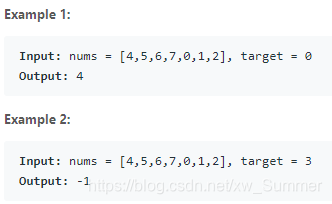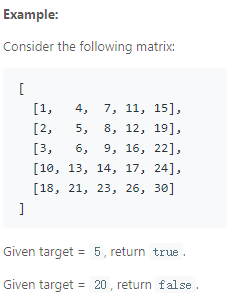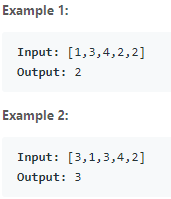33. Search in Rotated Sorted Array
Suppose an array sorted in ascending order is rotated at some pivot unknown to you beforehand.
(i.e., [0,1,2,4,5,6,7] might become [4,5,6,7,0,1,2]).
You are given a target value to search. If found in the array return its index, otherwise return -1.
You may assume no duplicate exists in the array.
Your algorithm’s runtime complexity must be in the order of O(log n).
Concise O(log N) Binary search solution:
class Solution {
public:
int search(int A[], int n, int target) {
int lo=0,hi=n-1;
// find the index of the smallest value using binary search.
// Loop will terminate since mid < hi, and lo or hi will shrink by at least 1.
// Proof by contradiction that mid < hi: if mid==hi, then lo==hi and loop would have been terminated.
while(lo<hi){
int mid=(lo+hi)/2;
if(A[mid]>A[hi]) lo=mid+1;
else hi=mid;
}
// lo==hi is the index of the smallest value and also the number of places rotated.
int rot=lo;
lo=0;hi=n-1;
// The usual binary search and accounting for rotation.
while(lo<=hi){
int mid=(lo+hi)/2;
int realmid=(mid+rot)%n;
if(A[realmid]==target)return realmid;
if(A[realmid]<target)lo=mid+1;
else hi=mid-1;
}
return -1;
}
};
34. Find First and Last Position of Element in Sorted Array
Given an array of integers nums sorted in ascending order, find the starting and ending position of a given target value.
Your algorithm’s runtime complexity must be in the order of O(log n).
If the target is not found in the array, return [-1, -1].
A very simple Java solution, with only one binary search algorithm:
public class Solution {
public int[] searchRange(int[] A, int target) {
int start = Solution.firstGreaterEqual(A, target);
if (start == A.length || A[start] != target) {
return new int[]{-1, -1};
}
return new int[]{start, Solution.firstGreaterEqual(A, target + 1) - 1};
}
//find the first number that is greater than or equal to target.
//could return A.length if target is greater than A[A.length-1].
//actually this is the same as lower_bound in C++ STL.
private static int firstGreaterEqual(int[] A, int target) {
int low = 0, high = A.length;
while (low < high) {
int mid = low + ((high - low) >> 1);
//low <= mid < high
if (A[mid] < target) {
low = mid + 1;
} else {
//should not be mid-1 when A[mid]==target.
//could be mid even if A[mid]>target because mid<high.
high = mid;
}
}
return low;
}
}
240. Search a 2D Matrix II
Write an efficient algorithm that searches for a value in an m x n matrix. This matrix has the following properties:
- Integers in each row are sorted in ascending from left to right.
- Integers in each column are sorted in ascending from top to bottom.
My concise O(m+n) Java solution:
We start search the matrix from top right corner, initialize the current position to top right corner, if the target is greater than the value in current position, then the target can not be in entire row of current position because the row is sorted, if the target is less than the value in current position, then the target can not in the entire column because the column is sorted too. We can rule out one row or one column each time, so the time complexity is O(m+n).
public class Solution {
public boolean searchMatrix(int[][] matrix, int target) {
if(matrix == null || matrix.length < 1 || matrix[0].length <1) {
return false;
}
int col = matrix[0].length-1;
int row = 0;
while(col >= 0 && row <= matrix.length-1) {
if(target == matrix[row][col]) {
return true;
} else if(target < matrix[row][col]) {
col--;
} else if(target > matrix[row][col]) {
row++;
}
}
return false;
}
}
287. Find the Duplicate Number
Given an array nums containing n + 1 integers where each integer is between 1 and n (inclusive), prove that at least one duplicate number must exist. Assume that there is only one duplicate number, find the duplicate one.
Note:
- You must not modify the array (assume the array is read only).
- You must use only constant, O(1) extra space.
- Your runtime complexity should be less than O(n2).
- There is only one duplicate number in the array, but it could be repeated more than once.
My easy understood solution with O(n) time and O(1) space without modifying the array. With clear explanation:
The main idea is the same with problem Linked List Cycle II,https://leetcode.com/problems/linked-list-cycle-ii/. Use two pointers the fast and the slow. The fast one goes forward two steps each time, while the slow one goes only step each time. They must meet the same item when slow== fast. In fact, they meet in a circle, the duplicate number must be the entry point of the circle when visiting the array from nums[0]. Next we just need to find the entry point. We use a point(we can use the fast one before) to visit form begining with one step each time, do the same job to slow. When fast==slow, they meet at the entry point of the circle. The easy understood code is as follows.
class Solution {
int findDuplicate3(vector<int>& nums)
{
if (nums.size() > 1)
{
int slow = nums[0];
int fast = nums[nums[0]];
while (slow != fast)
{
slow = nums[slow];
fast = nums[nums[fast]];
}
fast = 0;
while (fast != slow)
{
fast = nums[fast];
slow = nums[slow];
}
return slow;
}
return -1;
}
}
300. Longest Increasing Subsequence
Given an unsorted array of integers, find the length of longest increasing subsequence.
Note:
- There may be more than one LIS combination, it is only necessary for you to return the length.
- Your algorithm should run in O(n2) complexity.
Follow up: Could you improve it to O(n log n) time complexity?
Short Java solution using DP O(n log n):
public class Solution {
public int lengthOfLIS(int[] nums) {
int[] dp = new int[nums.length];
int len = 0;
for(int x : nums) {
int i = Arrays.binarySearch(dp, 0, len, x);
if(i < 0) i = -(i + 1);
dp[i] = x;
if(i == len) len++;
}
return len;
}
}




